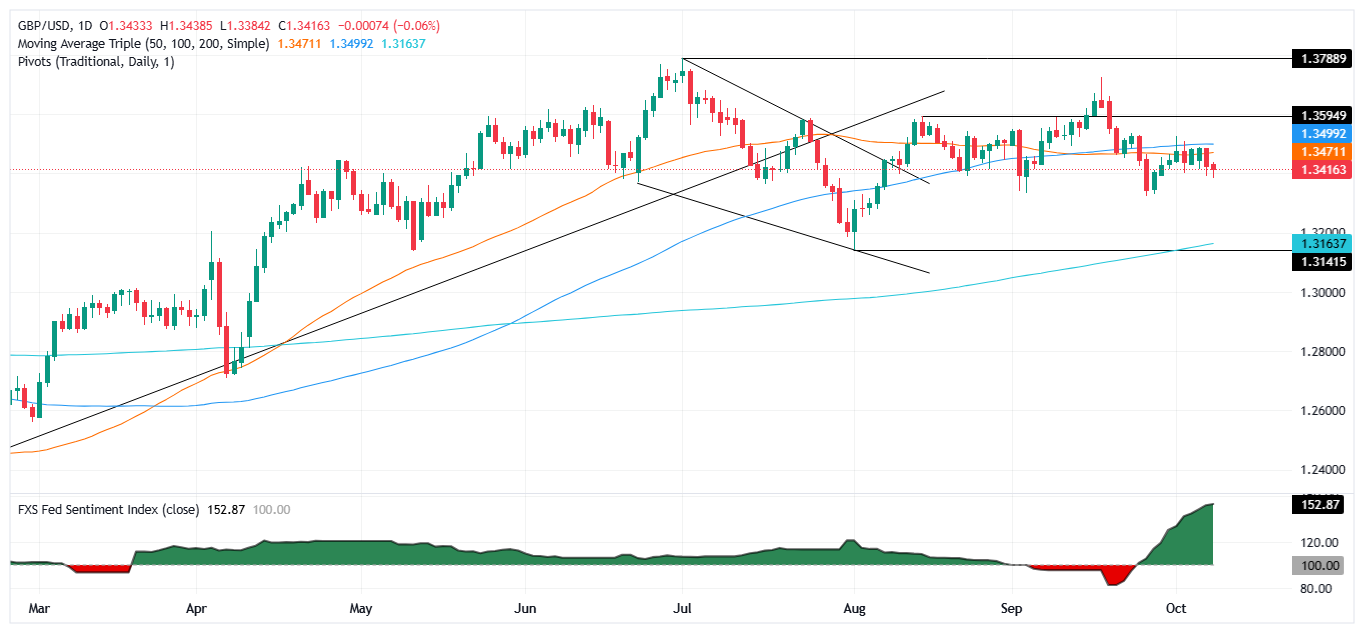GBP/USD stabilizes as Dollar eases, as traders await Fed minutes
- GBP/USD lifted by risk appetite, while DXY retreats from highs.
- Traders eye upcoming Fed minutes for policy clues, amid the US government shutdown entering its eighth day.
- BoE’s Huw Pill stresses focus on price stability, warning policymakers must stay committed to taming inflation.
The GBP/USD recovers ground on Wednesday as the Greenback trims some of its earlier gains amid a scarce economic docket on both sides of the Atlantic. At the time of writing, the pair trades at 1.3425 up 0.08%.
Sterling finds footing near 1.34 amid improved sentiment and cautious tone from global policymakers
The British Pound stopped the bleeding as risk appetite improved and the buck, retreated. Nevertheless, the US Dollar Index (DXY), which tracks the performance of the buck’s value against a basket of six currencies, including Sterling, is up 0.25% at 98.82, but beneath daily highs of 98.98.
The US government shutdown extends to its eight straight days. Bloomberg Wasson revealed that US House Speaker Johnson opposes any attempt to end the Senate filibuster to bypass Democrats and reopen the government.
The lack of economic data in the US left traders adrift to comments by Federal Reserve officials. St. Louis Fed Alberto Musalem and Governor Michael Barr crossed the wires but did not comment on monetary policy or the economic outlook. Later, traders will digest the latest minutes of the Federal Open Market Committee (FOMC) monetary policy meeting.
Additionally, investors would digest words from Minneapolis Fed Neel Kashkari, Dallas Fed Lorie Logan and once more Fed Governor Michael Barr.
Across the pond, analysts estimate the UK economy to grow modestly, while inflation remains high near 4. They are also penciling the release of the British fiscal budget on November 26, which has the potential of tax hikes to meet fiscal rules.
Meanwhile BoE Chief Economist Huw Pill is crossing the wires, said that monetary policy should be resolutely focused on price stability and that policymakers should make a clear and credible commitment to achieve the inflation objective. On Thursday, traders eye BoE Catherine Mann speech.
GBP/USD Price Forecast: Technical outlook
The GBP/USD remains subdued, set to remain below 1.3500 for the foreseeable week. Key resistance levels should be surpassed, so buyers could gain control and push the pair towards the September peak at 1.3726. The next resistance zone is the 50-day SMA at 1.3468, the 20-day SMA at 1.3490, the 100-day SMA at 1.3495 and the 1.3500 figure.
On the flipside, a drop below the September 25 swing low of 1.3324, clears the path to assess the 200-day SMA at 1.3160.

Pound Sterling FAQs
The Pound Sterling (GBP) is the oldest currency in the world (886 AD) and the official currency of the United Kingdom. It is the fourth most traded unit for foreign exchange (FX) in the world, accounting for 12% of all transactions, averaging $630 billion a day, according to 2022 data. Its key trading pairs are GBP/USD, also known as ‘Cable’, which accounts for 11% of FX, GBP/JPY, or the ‘Dragon’ as it is known by traders (3%), and EUR/GBP (2%). The Pound Sterling is issued by the Bank of England (BoE).
The single most important factor influencing the value of the Pound Sterling is monetary policy decided by the Bank of England. The BoE bases its decisions on whether it has achieved its primary goal of “price stability” – a steady inflation rate of around 2%. Its primary tool for achieving this is the adjustment of interest rates. When inflation is too high, the BoE will try to rein it in by raising interest rates, making it more expensive for people and businesses to access credit. This is generally positive for GBP, as higher interest rates make the UK a more attractive place for global investors to park their money. When inflation falls too low it is a sign economic growth is slowing. In this scenario, the BoE will consider lowering interest rates to cheapen credit so businesses will borrow more to invest in growth-generating projects.
Data releases gauge the health of the economy and can impact the value of the Pound Sterling. Indicators such as GDP, Manufacturing and Services PMIs, and employment can all influence the direction of the GBP. A strong economy is good for Sterling. Not only does it attract more foreign investment but it may encourage the BoE to put up interest rates, which will directly strengthen GBP. Otherwise, if economic data is weak, the Pound Sterling is likely to fall.
Another significant data release for the Pound Sterling is the Trade Balance. This indicator measures the difference between what a country earns from its exports and what it spends on imports over a given period. If a country produces highly sought-after exports, its currency will benefit purely from the extra demand created from foreign buyers seeking to purchase these goods. Therefore, a positive net Trade Balance strengthens a currency and vice versa for a negative balance.

